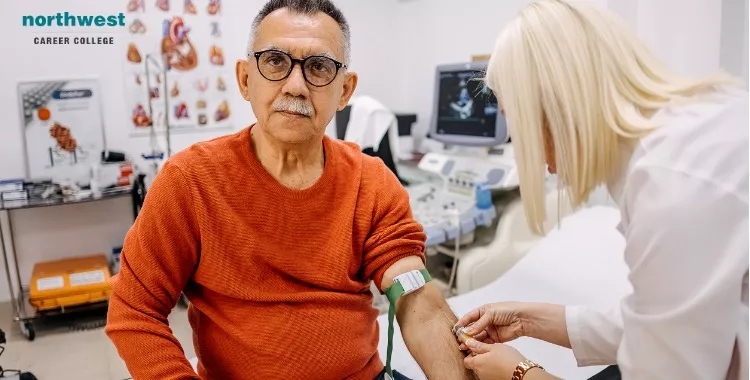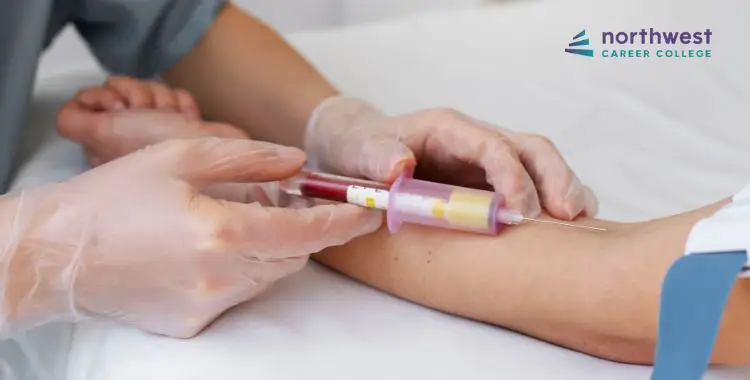Why Would a Patient Need Phlebotomy?
- Phlebotomy Technician
- October 25, 2024
- 5.8k views
- 5 min read

There are many reasons a patient might need phlebotomy, which is the process of drawing blood. Sometimes it’s for routine tests, such as a yearly check-up.
But sometimes, it’s needed for more serious reasons, such as to test for an illness or disease. Phlebotomy can also be used to treat some medical conditions.
So if you’re wondering why phlebotomy might be necessary for you or a loved one, read on to learn more.
Table of Contents
- Phlebotomy is the process of drawing blood from a vein in the body, usually from the arm.
- This procedure is used for various reasons, such as to collect blood for tests, transfusions, or donations.
- The phlebotomist will clean the area with an antiseptic before inserting a needle into the vein.
- Once the needle is inserted, they will draw out the required amount of blood and then remove the needle.
- A cotton ball or gauze may be applied to stop any bleeding and a bandage will be placed over it if necessary.
- The whole process usually takes less than 10 minutes and most people report feeling only minor discomfort during it.
- A critical medical process
- Start your new career today
Phlebotomy is the process of drawing blood from a vein in the body, usually from the arm.
Phlebotomy is a necessary procedure that involves withdrawing blood from the veins of a patient, most commonly located in the arms.
It is typically part of a medical practitioner’s routine to evaluate any conditions related to blood or other bodily fluids and can be performed quickly and with minimal discomfort for the patient.
People who undergo phlebotomy must have the utmost trust in their physician or nurse to ensure the utmost care and skill are used during this delicate process. With proper training, an experienced technician should be able to draw blood within minutes with great precision and accuracy.
This procedure is used for various reasons, such as to collect blood for tests, transfusions, or donations.
The procedure of drawing blood, known medically as venipuncture or phlebotomy, is an essential part of the diagnostic process.
This technique helps healthcare professionals to diagnose and treat medical issues, as it’s frequently used for analyzing the patient’s blood for signs of infection or disease. Venipuncture can also be used to collect either donor or patient’s blood for various purposes, such as the administration of transfusions and donating blood to those in need.
In addition to this, by collecting a small sample, doctors may also measure specific hormones or red blood cell count from the sample taken during a venipuncture.
Regardless of the reason why they use this procedure, healthcare professionals will create a safe environment when administering venipuncture to ensure their patients’ well-being and comfort.
The phlebotomist will clean the area with an antiseptic before inserting a needle into the vein.
Preparing for needle insertion is incredibly important, and it starts with the area that will be used. An experienced phlebotomist will start by cleaning the skin around the vein with an antiseptic to reduce any risk of infection.
This antiseptic solution slightly numbs the skin, allowing for a more comfortable experience with minimal bleeding. Once the area is clean, a phlebotomist will use a tourniquet to help find a suitable vein. This tourniquet helps as it increases blood pressure in the arm’s veins and makes them more visible.
Once the needle is inserted, they will draw out the required amount of blood and then remove the needle.
Blood tests are an essential part of many medical treatments, and their results can be used to diagnose a wide range of illnesses and conditions. Taking blood usually starts with a trained healthcare professional or phlebotomist sterilizing the area where the needle will be inserted.
Once the process begins, they will insert a needle into the vein and draw out the necessary amount of blood before removing it. It is essential to not move or tense your body during this procedure as it may cause pain or lead to problems obtaining enough blood for testing.
Blood tests are nothing to fear, and with experienced staff carrying them out, most people find them to be relatively comfortable experiences.
A cotton ball or gauze may be applied to stop any bleeding and a bandage will be placed over it if necessary.
Applying a cotton ball or gauze to any bleeding wounds is essential for ensuring that the injury heals properly. It can help to reduce the amount of blood loss and also act as a barrier against bacteria or other contaminants, which could further complicate the matter.
If bleeds persist for more than a few minutes, then it may be necessary to use a bandage over the cotton ball to help keep pressure on the wound and stop further bleeding.
The whole process usually takes less than 10 minutes and most people report feeling only minor discomfort during it.
Phlebotomy is a relatively low-risk procedure and generally has few side effects. However, it is essential to note that some people may experience lightheadedness, dizziness, or fainting during or after the procedure.
It is also essential for people to take extra precautions when caring for their wounds following phlebotomy. This includes keeping the wound dry and clean, avoiding using any harsh products on or near the area of the cut, and avoiding activities that may cause further trauma to the wound.
It is also crucial for people to follow up with their doctor after a phlebotomy procedure to ensure that they are healing correctly and there are no signs of infection.
A critical medical process
Phlebotomy is a crucial process that helps us understand and treat various medical conditions. It’s essential to have trained professionals who can perform this procedure correctly and with care.
If you’re interested in becoming a phlebotomist, Northwest Career College offers an excellent Phlebotomy Program.
Start your new career today
At Northwest Career College, we pride ourselves on providing one of the premier phlebotomy school las vegas.
Our established and seasoned instructors will take you through every aspect of Phlebotomy and Northwest offers day, afternoon, and night classes to accommodate your busy Las Vegas work and family schedule.
Call us today at (702) 403-1592 to speak to one of our admissions specialists about your new Phlebotomy career.





